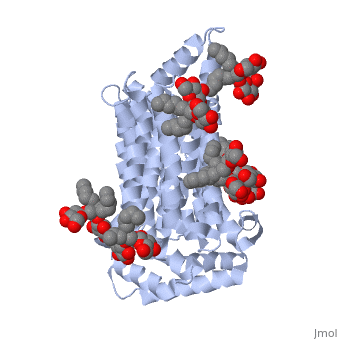You may include any references to papers as in: the use of JSmol in Proteopedia [1] or to the article describing Jmol [2] to the rescue.
Function
The main function of this protein is glucose transmembrane transport. It is one of fourteen facilitative sugar transporters. [3]
GLUT3 is categorized as a Class I transporter due to its protein sequence and structural similarity to other glucose transporters grouped in Class I. GLUT3 displays the highest affinity for glucose of all of the Class I glucose transporters and has a transport capacity five times greater than that of GLUT1 and GLUT4[4]. In humans, GLUT3 is found predominantly in brain tissue, highly and specifically expressed by neurons, and has some expression in peripheral tissues. For this reason GLUT3 is commonly known as the “neuronal glucose transporter”[3][4]. GLUT3 has a more restricted expression pathway, which represents specialized functions for the protein[5]. GLUT3 has been found to play an important role in gestational development and maintaining the brain's structure.
Disease
Defects in GLUT3 can cause fetal death as well as neurodegeneration, which can lead to diseases like Alzheimer’s.
Structural highlights
GLUT3 has 481 amino acids, which compose 28 alpha helices.
Its are Leucine, Alanine, Phenylalanine, Isoleucine.
Its are Serine, Glutamic Acid, Arginine, Threonine.

